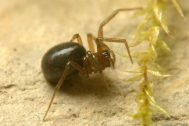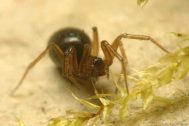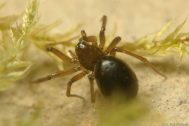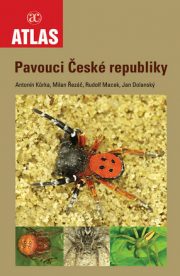| Records by time | |||||
|---|---|---|---|---|---|
| Linyphiidae | 0-1900 | 1901-1950 | 1951-2000 | 2001+ | ∑ |
| Centromerus incilium (L. Koch, 1881) Endangered | 4× | 170× | 17× | 191× | |
Centromerus incilium (L. Koch, 1881)
| Czech name | plachetnatka suchomilná |
|---|---|
| Threat level | Endangered |
| Records | 191 nálezů, 52 kvadrátů |
| First record |
1940, F. Miller, Miller & Kratochvíl 1940b |
| Last record | 2023 , Kryštof Rückl |
| Distribution area | European - eM (U |
| Phytogeographic area |
|
| Původnost stanovišť |
|
| Humidity |
|
| Stratum |
|
| Osvětlení stanovišť |
|
| Hojnost výskytu |
|
| Altitude | 200-1250 |
Bibliography
Výsledky faunistického průzkumu pavouků a sekáčů na vybraných lokalitách na území NP Podyjí v roce 2019
A total of 114 spider species from 25 families and one harvestmen species were found during the zoological research at several sites in the Podyjí National Park during 2019. Of them, forty-one species are listed in the Red List of spiders of the Czech Republic. Four new species for the Podyjí NP were recorded – Callilepis nocturna (Linnaeus, 1758), Euryopis laeta (Westring, 1861), Phrurolithus minimus C. L. Koch, 1839 and Trichoncus auritus (L. Koch, 1869). Among the most interesting species, four critically endangered spiders – Civizelotes caucasius (L. Koch, 1866), Phrurolithus szilyi Herman, 1879, Gnaphosa modestior Kulczyński, 1897 and Eresus moravicus Řezáč, 2008 should be mentioned. Other rare species include Acartauchenius scurrilis (O. Pickard-Cambridge, 1873), Agyneta fuscipalpa (C. L. Koch, 1836), Arctosa figurata (Simon, 1876), Atypus affinis Eichwald, 1830, Bassaniodes robustus (Hahn, 1832), Callilepis schuszteri (Herman, 1879), Centromerus incilium (L. Koch, 1881), Centromerus leruthi Fage, 1933, Cheiracanthium effossum Herman, 1879, Drassyllus villicus (Thorell, 1875), Euryopis quinqueguttata Thorell, 1875, Frontinellina frutetorum (C. L. Koch, 1835), Gibbaranea gibbosa (Walckenaer, 1802), Gnaphosa opaca Herman, 1879, Haplodrassus cognatus (Westring, 1861), Haplodrassus dalmatensis (L. Koch, 1866), Haplodrassus minor (O. Pickard-Cambridge, 1879), Heterotheridion nigrovariegatum (Simon, 1873), Kishidaia conspicua (L. Koch, 1866), Leptorchestes berolinensis (C. L. Koch, 1846), Minicia marginella (Wider, 1834), Phrurolithus pullatus Kulczyński, 1897, Trichopterna cito (O. Pickard-Cambridge, 1873), Walckenaeria simplex Chyzer, 1894, Zelotes erebeus (Thorell, 1871) and Zora manicata Simon, 1878.Pavouci (Araneae) a střevlíkovití brouci (Coleoptera, Carabidae) vybraných vřesovišť v západních Čechách.
Results of the exploration of the araneofauna and the entomofauna in West Bohemian heathlands are presented. Spiders and carabid beetles were collected during the vegetation seasons in 2011 and 2012 by the method of pitfall trapping. In total, 3188 specimens of 171 Araneae species and 2168 specimens of 93 Carabid species were determined. The most frequent spiders were Xerolycosa nemoralis (Westring, 1861), a common forest species. The following identified species are listed among the endangered spiders in the Czech Republic in the category „endangered“: Alopecosa schmidti (Hahn, 1835), Micaria dives (Lucas, 1846), Peponocranium orbiculatum (O. P.-Cambridge, 1882), in the category „vulnerable“: Centromerus incilium (L. Koch, 1881), Evansia merens O. P.-Cambridge, 1900, Metopobactrus prominulus (O. P.-Cambridge, 1872), Arctosa figurata (Simon, 1876), Arctosa lutetiana (Simon, 1876), Pardosa nigriceps (Thorell, 1872), Gnaphosa bicolor (Hahn, 1833), Xysticus striatipes L. Koch, 1870, Evarcha laetabunda (C. L. Koch, 1846) and Trichopterna cito (Blackwall, 1841). The most remarkable species of the Carabids were the Amara equestris equestris (Duftschmid, 1812), Amara pulpani Kult, 1949, Bradycellus ruficollis (Stephens, 1828), Carabus arcensis arcensis Herbst, 1784, Carabus problematicus harcyniae Sturm, 1815, Cymindis axillaris axillaris (Fabricius, 1794), Cymindis vaporariorum (Linné, 1758), Masoreus wetterhallii wetterhallii (Gyllenhal, 1813), Olisthopus rotundatus rotundatus (Paykull, 1790). Studied material was reposited at the Department of Zoology of the West Bohemian Museum in Pilsen.
Gallery
Statistics
By month
By altitude
By collecting method (191 used records)
| Centromerus incilium (L. Koch, 1881) VU | Males | Females | Juveniles | Records |
|---|---|---|---|---|
| Individuální sběr | 1 | 4 | 0 | 4 |
| Prosev | 1 | 3 | 0 | 4 |
| Zemní past | 206 | 154 | 0 | 126 |
| Neurčeno | 29 | 19 | 0 | 52 |
| Smyk | 6 | 1 | 0 | 3 |
| Sklepávání | 1 | 0 | 0 | 2 |
| Males | Females | Juveniles | Records |
By biotope (191 used records)
| Centromerus incilium (L. Koch, 1881) VU | Males | Females | Juveniles | Records |
|---|---|---|---|---|
| Písčiny | 12 | 5 | 0 | 6 |
| Dubohabřiny | 1 | 0 | 0 | 1 |
| Neurčeno | 37 | 53 | 0 | 57 |
| Suché doubravy | 19 | 25 | 0 | 22 |
| Ovocné sady s luční vegetací | 2 | 0 | 0 | 2 |
| Stinné skály nižších poloh | 2 | 3 | 0 | 3 |
| Suché louky | 5 | 17 | 0 | 13 |
| Xerotermní travinobylinná společenstva | 2 | 0 | 0 | 1 |
| Horské bučiny | 1 | 0 | 0 | 1 |
| Reliktní bory na skalách | 3 | 4 | 0 | 4 |
| Suťové a roklinové lesy | 0 | 1 | 0 | 1 |
| Porosty borůvek | 90 | 34 | 0 | 18 |
| Výsadby jehličnanů | 1 | 7 | 0 | 6 |
| Lesní okraje | 1 | 1 | 0 | 2 |
| Acidofilní bory | 29 | 10 | 0 | 18 |
| Mezofilní louky | 1 | 0 | 0 | 1 |
| Mokré louky | 2 | 1 | 0 | 2 |
| Luční ostřicové mokřady | 0 | 2 | 0 | 2 |
| Lesostepní doubravy | 6 | 5 | 0 | 5 |
| Paseky | 1 | 0 | 0 | 1 |
| Suché křoviny | 1 | 1 | 0 | 2 |
| Přirozené lesy | 4 | 4 | 0 | 5 |
| Kamenité suti nižších poloh | 2 | 0 | 0 | 2 |
| Břehy tekoucích vod | 3 | 0 | 0 | 2 |
| Močály | 5 | 0 | 0 | 1 |
| Rákosiny a orobincové porosty stojatých vod | 0 | 0 | 0 | 1 |
| Skalní stepi na vápenci | 14 | 7 | 0 | 9 |
| Louky | 0 | 0 | 0 | 1 |
| Lesy | 0 | 1 | 0 | 2 |
| Males | Females | Juveniles | Records |







